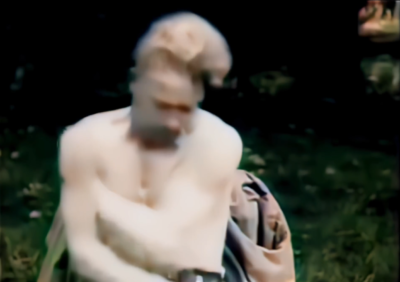How does the body remember? Doctors began treating tens of thousands troops (those who were not shot by their own comrades for failing to perform their duties) who could not stop performing compulsive and repetitive gestures. They called it shell shock, named for the new modern warfare which deployed concussive explosives against waves of men pouring from the trenches. What they couldn’t help observing was the work of the second kind of memory, the mémoire, a kind of wild memory expressed across the entire body. A visual essay in three parts.
“From 1917 to 1918, Major Arthur Hurst filmed shell-shocked patients home from the war in France. Funded by the Medical Research Committee, and using Pathé cameramen, he recorded soldiers who suffered from intractable movement disorders as they underwent treatment at the Royal Victoria Hospital in Netley and undertook programs of occupational therapy at Seale Hayne in Devon.” Edgar Jones
“Mike Hoolboom’s Veterans presents colorized British Pathé footage from shellshocked British war soldiers. It is a meditation on a disturbing form of embodied human memory; but, unlike the alteration of the historic material, the psychophysical alterations of the soldiers is so overwhelming that one has a hard time watching. Every one of these fifteen war veterans has their own eerie tick or spasm that render them unfit to re-enter civilian life.
These images demonstrate how the horrors of the war are recorded directly onto human cell tissues. ‘Sometimes this memory is violent because memory is a wild piece of the body inside ourselves,’ Hoolboom adds in the voice-over, citing Swiss film curator and writer Jean Perret…
Then suddenly, Hoolboom literally pulls the curtains. The images are now projected onto a wall of smoke. Blurred and increasingly illegible, they spiral into light fragments. They could be rejected memories. One can only imagine the echoes that continue to sound inside bodies that are caught in loops of the past. The body stores every memory, even the ones we can’t recall.
After a few seconds, Mike appears in this image flow as a silhouette. He is a ghostly appearance as the downward-gushing flow of imagery seems to react and acknowledge the presence of his body. The images appear to bounce off his head and shoulders. Mike is eventually joined by another silhouette—one touches the other as the film closes with a reconciling optimistic gesture, letting us wonder what actually soothes. Do we forget pain the moment we connect or even begin to love? It’s never that simple. The voice-over ends with: ‘Love is something very brutal,’ as Hoolboom again cites his friend Perret. Like pain, love is deeply embodied and informed by our past experiences, the ones we can’t remember and those that refuse to forget us.” Caspar Stracke
